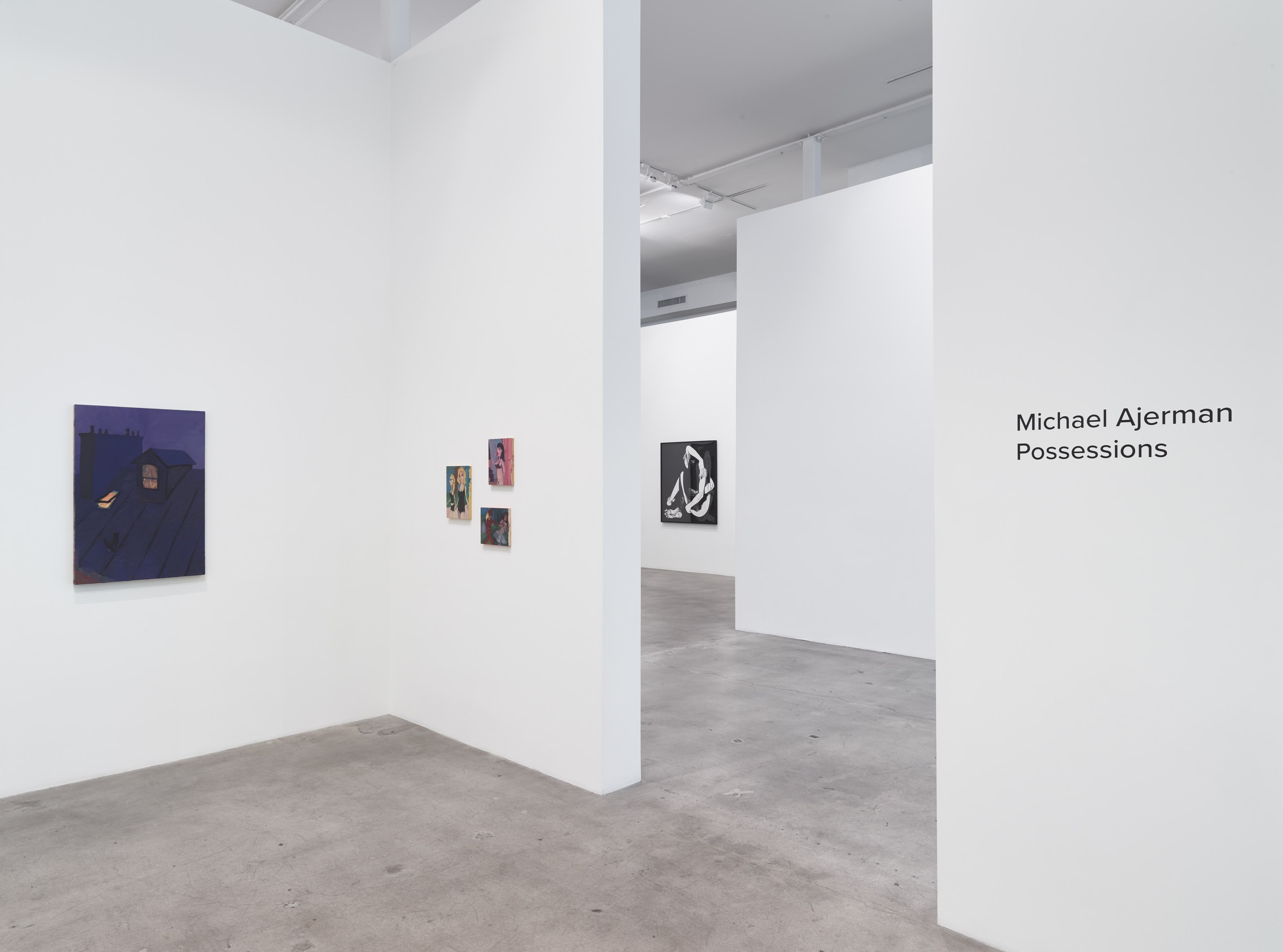
Michael Ajerman and Marty Schnapf each offer their own elegant and sensual images in two strong solo shows at Diane Rosenstein Gallery. While Ajerman works with vivid colors in his figurative oil paintings, Schnapf’s current body of work is in nearly-life-size black and white. Both offer deeply intimate expressions that are filled with energy and pulsing with life. There is a physicality to both artists’ work that makes them ideally paired, although the outward appearance of each exhibition is visually diverse in palette and style.
They share the same subject, however: the human figure; or in Ajerman’s case, at times fantastical versions of men and women. The artists also share the same theme: human feeling. They hum with resonance for the viewer, as if the subjects were ready to step from the works and into the real world.
Ajerman’s Possessions marks the first exhibition in Los Angeles for the London-based artist. His paintings depict moments of intimacy and domesticity, and feature narratives as familiar and recognizable as Pinocchio and Tinkerbell. In each painting, however — though the color palette is wide and rich — darker energies are indeed amidst, as if something seethes unseen beneath the surface. Yet these works also offer a sense of humor in the very depiction of the ludicrous and lovely nature of life itself.
In Lolli, a dark haired, luminously pink woman, clad only in a bra, licks a lollipop. It is both seductive and playful. Two Women in Turin offers a more natural color palate and a graceful look at two women, apparently clad in swimming attire, loosely holding hands. One looks toward us as if skeptically assessing a photographer capturing a private moment. There is both a lighthearted quality to the work and the sense that viewers are beckoned to share a personal moment, perhaps one intended to be more private. Ajerman’s Mermaid and Vampire gives us fantasy figures, awash in a cloud of fluffy pink. The mermaid reclines on the golden sand, looking up at the vampire hanging above her. The immediate thought is: can this relationship ever work? Perhaps they’ll try.
The titular work here, Possessions, is one of the darker pieces exhibited both in terms of color and subject. Here, a vividly blonde woman – her hair the brightest hue in the painting, clad in a red cat suit and wearing a mask, is grabbing the purse of another woman. It’s a provocative piece in many ways: woman on woman attack; the brightness of the thief’s hair, the shadowed face of her victim; the boldness of the thief’s physicality, and the shyness of the woman with the bag. The viewer feels as if it is a commentary on our current socio-political culture, in which the “robber” mentality is the victor – if we allow ourselves to be victims, and try only to hang on to what we have. The red color of the thief’s attire immediately calls to mind a devil of sorts, and with that reference, brings the thought that the things we most hold on to may be summoning the wrong elements into our lives.
Other pieces, such as Lovers by the Apple Tree, are clearly about sexual appetites; these lovers are depicted fully in flagrante delicto, caught under the red ripe fruit of the apple tree, engaged in intimate relations in what could be a public space. Best of all, is not what they are doing but who they are: Pinocchio – whose nose appears not to be the only part of his anatomy to grow; and the flutteringly-winged Tinkerbell. Like the mermaid and vampire, this is one interesting match of opposites.
In contrast, December’s Painting is a peaceful home scene, an entirely different form of intimacy, in which a nude woman sits on her sofa, her dog on the other end of the couch. By the Sea Wall gives us a similar aesthetic, a man sweetly cuddling his pet along a walk beside a dark and seemingly moonlit sea. The artist’s use of blues and pinks in the works exhibited here is wonderfully unique; the colors are expressions of moods, and seem representative of dreams.
Intimacy is also the focus of LA-based Marty Schnapf; his Loves and Lovers is his first solo show at the gallery. Working in black and white, using charcoal, he has created large-scale, intertwined figures and single figures that are graceful, filled with movement, and which, as with Ajerman’s work, offer the viewer a rich insight into a personal world.
The physicality of the works, their spareness and their grace are all beautiful; the individual strength of each piece is the mysterious quality of the dark backgrounds and white figures, as if they were players moving across a darkened stage – the stage of life. With a piece such as Stars so Bright, a contorted male figure is bent in a kind of ballet with another hidden figure – save for the masculine feet – positioned behind him. With You have the chance to be more beautiful than you’ve ever been, a man and a woman are inextricably intertwined, bound together in a dance of love-making and love. The woman’s head is thrown back, as if in ecstasy, their hands linked together, bodies pressed together, her figure tightly against his in a seated position. Equally bound, ecstatic, and passionate is Perhaps you think you might fall away. The smaller figure here is cradled, held, pressed up against the larger; both have faces obscured. In contrast, there is anger, perhaps subjugation in the wrestling-like positions of Hairpin Turn. It is difficult to tell the true import behind Sometimes a sapphire, but the viewer is struck by the bowed and bent positioning, the figurative elements in crosshatched shadows, the mystery in the capture of a human being in an almost-impossible pose.
The motion – caught precisely, a profound recreation not just of movement but of the act of being alive – which these works have is astonishing; all the more so for their monochromatic palette and the wild, consuming nature of the acts which Schnapf has frozen in time. The largeness of their scale renders them even more compelling; the artist’s use of line, his perfection of the human body, its mobility, and the meaning that seems to slip from our very limbs, is exquisite. Both the intensity and the somewhat enigmatic nature of the artist’s work draw the viewer into the world in which his people live; we want to understand their emotions, what is happening between or within them.
Both artists bring viewers into the intimate lives of their subjects, and in so doing, connect viewers more intimately to themselves as well.
